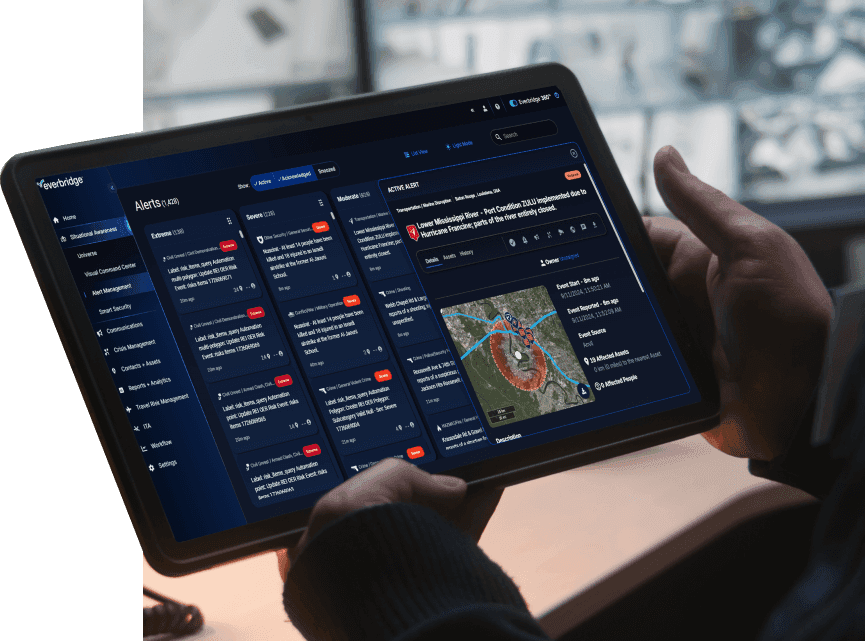It is no surprise that resilience has become a frequently identified trait for success. McKinsey stated, “To thrive in the coming decade, companies must develop resilience—the ability to withstand unpredictable threat or change and then to emerge stronger”. Organizations want to know how to measure organizational resilience, where do they start?
Strengthening resilience requires organizations to take a step back and assess how they measure up to their competitors and what processes need the most attention. From there, organizations can more successfully build out resilient operations by identifying specific areas of improvement and the right technology to solve their unique challenges.
What is organizational resilience?
Critical events can vary widely in type, severity, and scope—from natural disasters to IT outages—and a drawn-out response can lead to significant operational losses, disruption to supply chains, brand damage, and concerns for health and safety.
Organizational resilience is an organization’s ability to withstand events with the least possible impact on safety, reputation, and operations. But it’s not enough to simply know the definition of organizational resilience. In truth, leaders need to know precisely how to measure business resilience and understand the steps they can take to strengthen resilience in the future.
It’s vital to understand how frequently critical events occur and the research behind why strengthening resilience should be a number one priority for organizations. Creating and maintaining a resilient organization is a long-term strategy that requires full commitment from every business level. Learn more from The Research Behind Resilience, an eBook developed for North American organizations about the data on why prioritizing and investing in resilience matters.
What are the most common critical events businesses face?
According to recent Forrester research, Business Resiliency Is The Bulwark To A World Defined By Systemic Risk And Chaos, systemic risk events are increasing in frequency and magnitude. As their research stated:
- Hurricanes will continue to cause more damage, while being more dangerous and more destructive, due to climate change.
- Wildfires will continue to cause more damage, while being more dangerous and more destructive, due to climate change.
- Pandemics, epidemics, and disease outbreaks will become more frequent. As the world continues to be interconnected, pandemics and epidemics will affect how, when, and where employees can work as well as customer buying patterns.
- Global economic recessions will significantly alter business plans or cause failure. There have been five global recessions since 1960, three of which have been since 1990.
Planning for critical events is a vital part of being a successful business that takes care of its customers, employees, and partners. See how other North American organizations are better managing critical events and strengthening resilience in our latest eBook.
Why do organizations need to be resilient?
North America has experienced an increase in both the number and severity of critical events in the last three years. For example, 83% of organizations that were interviewed for IBM’s “Cost of a Data Breach Report 2022” have now experienced more than one data breach.
The Harvard Business Review stated, “performance during crisis periods has almost three times the impact of performance during stable periods.” The ability to maintain operations during a crisis is imperative to the long-term success of an organization.
Additionally, in our “Research Behind Resilience” eBook, we explore how organizations that prioritize and invest in resilience experience:
- Significant reduction in their financial losses from critical events—up to $3 million in efficiency gains over three years
- Reduced business interruption and downtime
- More time spent on productivity rather than managing a crisis
Download “The Research Behind Resilience” eBook to learn even more ways in which organizations are benefiting from building more resilient environments.
How to measure organizational resilience
Measuring organizational resilience is a unique undertaking that requires full organizational transparency, and a thorough understanding of your existing operational structure and continuity planning. When working with Everbridge, our measurement structure evaluates four specific areas:
- Your ability to identify and assess risks to your operations
- Your ability to locate people and assets that might be in harm’s way
- Your ability to act or execute standard operating procedures (SOPs) and protocols
- Your ability to analyze performance before, during, and after a critical event
In most organizations, no single individual has all the details necessary to effectively gauge the resilience of an entire organization. Collaboration across departments and teams that have direct knowledge of these four components can simplify and expedite the process. In our Research Behind Resilience eBook for North American organizations, it was revealed that there’s great potential to build organizational resilience, and doing so ultimately reduces financial losses.
Benefits of a mature approach
A mature approach to critical event management isn’t just a box to check off in executive planning meetings; it’s a greatly beneficial approach that improves business across the board and helps build a resilient organization. By ensuring organizational resilience, you show that you’re dedicated to:
- Keeping people safe
- Maintaining business continuity and operational uptime
- Optimizing supply chains and routes
- Operationalizing the safety of smart buildings and the internet of things (IoT)
- Safeguarding reputation through resilient and responsive IT systems
- Fostering organizational resilience
The most mature organizations work across critical business functions, units, and departments, share internal resources and technology, make data-driven decisions, and regularly test and practice their response. According to the latest Forrester research, these organizations experience significant benefits from their critical event management approach such as creating a competitive advantage and better anticipation for future challenges.
All of the above considerations are essential in the foundation of businesses that will continue to see long-term success, and when one increases, they all do. It’s almost impossible to have growing revenue without a positive brand and reputation, and employee safety goes hand-in-hand with VIP safety. A mature approach to organizational resilience for critical events will ensure your organization is on the road to long-term success.

